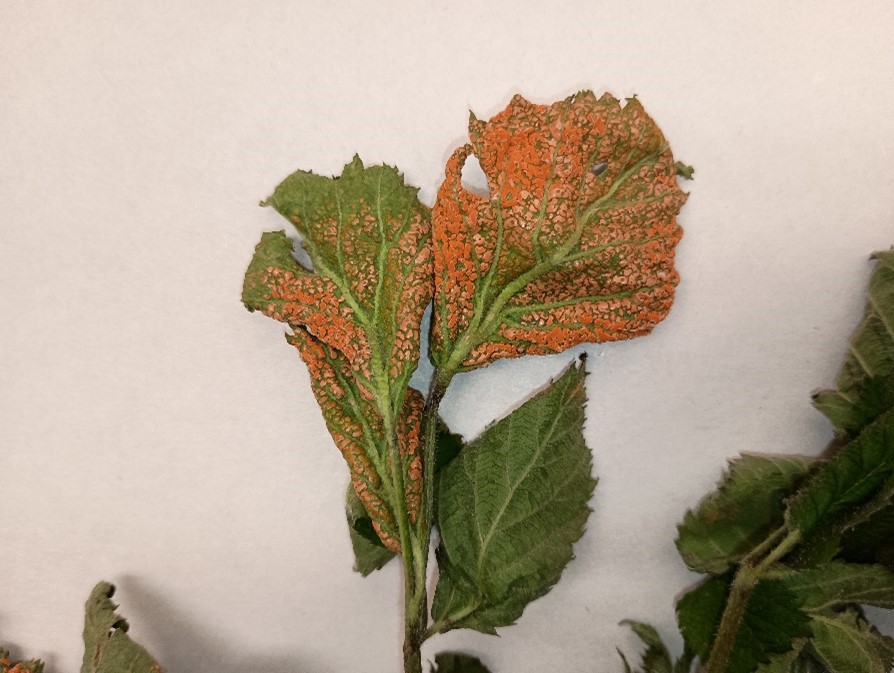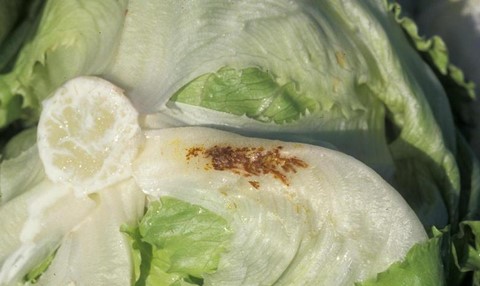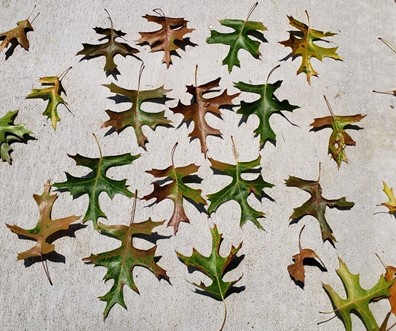Current samples
Orange Rust of Brambles
Peng Tian and Blaike Zehnle
Orange rust is a notable fungal disease impacting bramble species, particularly blackberries and certain raspberry cultivars. The disease, caused by fungi in the genus Arthuriomyces and Gymnoconia, is notorious for its ability to cause systemic infections that can severely diminish vegetative growth of affected plants and fruit production, leading to substantial economic losses. Therefore, a comprehensive understanding of the disease's symptoms, life cycle, and management strategies is critical for growers seeking to sustain healthy and productive bramble crops.

Symptoms and signs: The first symptoms of orange rust appear in early spring when new shoots and leaves emerge. Infected plants exhibit pale, yellowish-green leaves that may appear stunted or deformed. Black specks surrounded by chlorotic tissue will be present on the underside of the leaves. As the disease progresses, the characteristic orange, waxy pustules develop from the black specks (Figure 1). These pustules release bright orange, powdery spore masses that are easily spread by wind. Infected plants typically exhibit weak growth and produce fewer or no fruit as the disease systemically affects the entire plant.
Learn more about the diagnosis and management of this disease:
Rhizoctonia Bottom Rot of Lettuce
Peng Tian and Blaike Zehnle
Bottom Rot caused by Rhizoctonia solani was confirmed from a lettuce sample received by MU Plant Diagnostic Clinic. This soilborne fungus is known for causing damping-off and bottom rot on a broad range of plants when they approach maturity, both in open fields and under shelter. It is most economically damaging during harvest when growers must trim plants with rotten leaves, reducing both the quality and yield.

Symptoms and signs: Bottom rot symptoms typically develop first on lower leaves in contact with the soil and appear as small, rust-colored brown spots, mainly under leaf midribs (Figure 1). Symptoms generally are most pronounced at heading. Bottom rot can spread to midribs and leaf blades rapidly when conditions are favorable. Stems are relatively more resistant to bottom rot and are the last portion of the head to decay. Decaying heads are at first slimy and brown but become dark brown to black as they collapse and dry. A webbed network of white to brown mycelium often grows over lesions, and small gray, brown sclerotia later are apparent. Botrytis cinerea and bacteria may begin to colonize on the damaged tissues and accelerate the rotting.
Learn more about the diagnosis and management of this disease:
Bur Oak Blight
Peng Tian and Pierce Taylor
Across the Midwest, Bur Oak Blight (Tubakia iowensis) is a fungal pathogen infecting the Bur Oak (Quercus macrocarpa). Affected plants display chlorosis and fruiting bodies on the leaf vein and petiole in mid to late summer. The small-acorn variety of bur oak (Quercus macrocarpa var. oliviformis), is affected more severely than other varieties. The disease can reinfect trees year to year and can eventually cause death after several years of defoliation.

Symptoms and signs: Typical symptoms include necrosis(death) occurring around the leaf veins, as well as the tip. Eventually the fungus occurring on leaf veins result in tissue death. The presence of fruiting bodies can be seen along the veins on the underside of the leaf and around the petiole as a purple discoloration. Due to the death of foliage, Bur Oak Blight is often confused with Oak wilt or Anthracnose disease. These fruiting bodies, or pycnothyrium, presence on the petiole and the tree retaining its leaves over winter are symptoms of Bur Oak Blight which differentiate it from similar diseases. The conidia spores of Tubakia iowensis are microscopic and cannot be seen unaided, thus proper identification requires analysis with a laboratory microscope. Tubakia spp. have a pycnothyrium that composes of a shield like scutellum of radial projected hyphae. The scutellum is supported by a short columnar stalk that bears the round to ovoid conidia spores.
Learn more about the life cycle, damage and management of this disease:
Oak Wilt Disease
Peng Tian and Pierce Taylor
Oak Wilt is a fungal pathogen infecting oak trees, primarily of the Red Oak family. The causal agent is a fungus called Bretziella fagacearum that infects and kills oak trees in parks, woodlands, and residential areas across Missouri. Oak wilt was first detected in Wisconsin during the 1940’s and has since spread across the United States. Red oaks, trees with pointed leaf lobes, are affected more than white oaks, trees with round lobes. This pathogen is usually fatal to oak trees, with death occurring within the season following infection.

Symptoms and signs: Oak wilt affects the vasculature of the tree, resulting in a timely decline. In Red oaks, symptoms generally appear in late spring or early summer and include sectional canopy dieback at the top of the tree and thinning of the entire canopy. As entire sections of branches die off, leaves begin curling and desiccating from the outside inward. Leaves die due to a lack of vasculature within the branches of the tree, and by the end of the summer most leaves will fall off. In branches affected by Oak Wilt, brown staining can be observed under the bark. In White Oaks, symptoms are generally milder. Flagging of the leaves occurs in scattered patches and leaves generally become light brown in color. White Oak trees may die after one year of infection, but it can take several seasons for the tree to slowly decline.
Learn more about the life cycle and management of this disease:
Wheat Streak Mosaic Virus
Pierce Taylor and Peng Tian
Wheat streak mosaic virus (WSMV) is a plant virus that infects wheat and other cereal crops, causing significant economic losses in many regions of the world. WSMV is a serious threat to global food security, as it can significantly reduce crop yields and limit the availability of wheat and other cereal crops for food and feed. WSMV is part of the family Potyviridae, which includes many other economically significant plant viruses. WSMV is transmitted by a tiny, winged insect called Wheat Curl Mite (Aceria tosichella) (WCM), which can easily spread the virus from plant to plant.
Symptoms and signs: Symptoms of WSMV infection include characteristic yellow streaks on the leaves of infected plants. As the infection progresses, leaves take on a mottled appearance which can eventually lead to stunted growth, reduced yields, and even plant death in severe cases. Severity of the disease depends on plant age at the time of infection, environmental conditions. Warm (75-80°F, 24-27°C), dry weather promotes infection by stressing plants and encouraging the proliferation of the primary vector, the WCMs.
Learn more about the life cycle and management of this disease:
Check out previous highlights from the Plant Diagnostic Clinic.